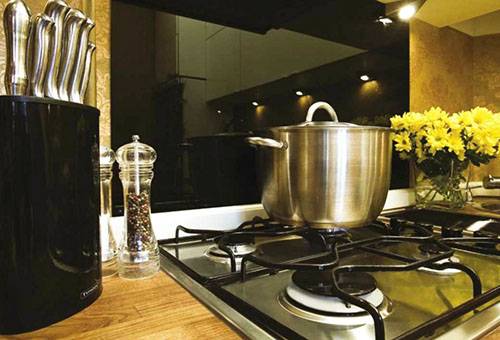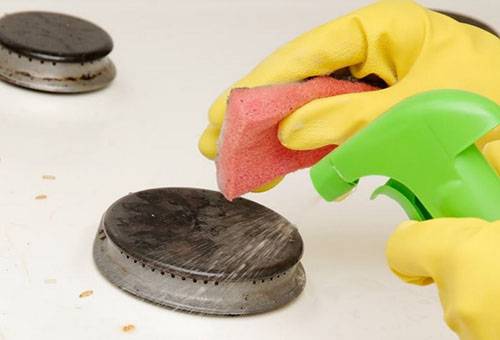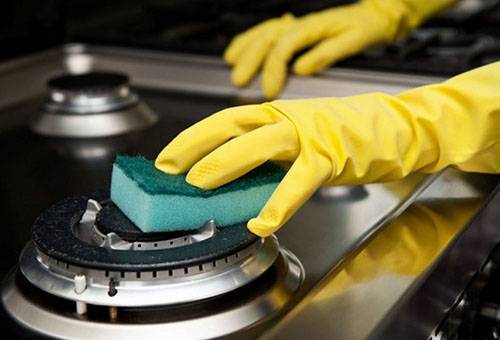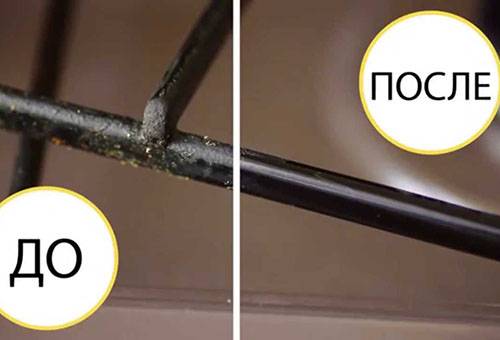How easy is it to clean a gas stove at home?
Content:
If you know how and how to wash the stove, grids and handles from soot and grease, do it correctly and regularly, then the cleaning process turns into a pleasure. In order to remove all impurities easily, you need to choose the right cleaning products.
The choice depends on the state of the tile and the type of surface. They are:
- enamelled steel;
- from shock-and heat-resistant glass ceramics (gas on glass);
- stainless steel - matt or polished.
If we talk about familiar stoves with a built-in oven - the most common version - then they mainly have an enameled surface, and occasionally there is a stainless steel. Gas hobs can be made in all three versions.
Cleaning products for enamel boards and glass-ceramic panels
Enamel, like glass ceramics, can be cleaned by almost any means. They may contain alkali or acid - this will not damage the surface. The only taboo for this type of tile is the mechanical cleaning of soot using metal brushes, scrapers or abrasive. Mistresses should know that salt or soda - harmless home remedies - are also an abrasive when dry. If you clean the panel with their help, then micro-scratches form on the glass or enamel and grease is clogged there, which is more and more difficult to clean every time, which means that more and more radical means are used every time.
To keep the stove in good condition, you must initially treat it carefully. Using soda to soften soot, you need to completely dissolve it in water. At the same time, it will not lose its properties, but the surface will not damage.
Some tips on how to easily wash heavily soiled tiles, including a sieve covered in enamel from grease, without using household chemicals.
- Prepare a strong saline solution (2 tablespoons per 0.5 l of water), apply to the stove and leave overnight. In the morning, wipe the tile dry and make the following remedy: dissolve 25 g of laundry soap in a small amount of hot water, add 50 g of vinegar and 20 g of soda ash or baking soda there. With this solution, cover the surface, and after 2-3 hours it can be removed with a damp sponge. All pollution will go away.
- Dissolve in cold water (200 ml) 1 tbsp. teaspoon of silicate glue, add there 1 teaspoon of powder or detergent and 3 tbsp. tablespoons of soda. Pour the contaminated surface with the resulting composition and wait 30-40 minutes, after which you can wipe the plate with a damp cloth. This method is suitable to clean the grill for any type of stove, including cast iron.
- For white enamel, ammonia (ammonia) can be used, then the tile will simply shine with cleanliness. The same recipe is also suitable for glass ceramics to remove the remaining stains, giving an unkempt look. After removing carbon deposits and fat deposits, wipe the surface with a solution of ammonia (1 teaspoon) and water (500-1000 ml).
In addition to the above funds, you can use household chemicals for "general" cleaning. Liquid and gel formulations are suitable; powders cannot be used. There is a limitation for enamel cleaning with the help of products containing acid: they can be used no more than once a month. When using factory tools, you also need to be patient, because in order for even the most “thermonuclear” tools to work, time is needed.After applying the liquid or gel, you need to wait 15-20 minutes, if the instructions do not say more.
Daily cleaning of enamel is carried out with an ordinary detergent and any sponge. But to wipe the glass ceramics you need to use a separate sponge, which does not wash other dishes and a special tool so that there are no stains. If there is no special tool, you can wash it with an ordinary one, but then you will have to additionally wipe the panel with a solution of ammonia and water or with a glass cleaner.
Tip
A rubberized napkin is best for cleaning glass ceramics, and a microfiber cloth for wiping dry.
How and how to clean a stainless steel panel?
Before you clean a stainless steel gas stove, you need to figure out which tools can be used for this, and which will only harm and ruin the look forever. The following solutions and formulations are prohibited:
- containing acid;
- containing chlorine;
- means with abrasive particles.
It should be said that aggressive household chemicals are not suitable for stainless steel tiles, so you can not start the process: it will be very difficult to clean stains of old fat and stubborn soot, especially on a polished panel. It is better to carry out daily cleaning thoroughly and, if something has run away and is burnt, clean it immediately.
If it was not possible to keep track and the old spots of burnt fat remained, you can prepare a solution:
- 200 ml of water;
- 1 tbsp. a spoon of silicate (clerical) glue;
- 25 g of grated soap on a coarse grater or 1 teaspoon of powder;
- 3 tbsp. tablespoons of soda.
You need to mix everything well, apply to the surface, and if the pens are of the same material, then on them, and rinse off after a few hours. After that, wipe dry and polish with the addition of a special polishing agent. Daily cleaning is carried out with the addition of a small amount of detergent, since its excess will not allow you to wash the panel from chemistry clean and stains remain. Dry stainless steel, as well as glass ceramics, is most conveniently microfiber cloths.
We clean the details
Before starting to wash the stove, you need to remove the removable elements. Lattices are removed at every wash, burners - as they become dirty, but the control knobs are best removed only during general cleaning. Another detail that needs periodic attention (once every several years) is nozzles. To clean them, you can invite a gasman, but you can carry out this procedure yourself at home.
Enamelled grilles are very easy to clean. If you have a dishwasher, you can lay them there. Manually cleaning them is also easy, all the same means are suitable as for the stove. In case of severe soot, you can put them in a basin with very hot water and detergent and leave for a couple of hours. After that, all the dirt is easily removed. An uncoated steel grill can be cleaned with any abrasive, metal washcloth or brush, but no acids, including vinegar, can be used. Cast iron grates are worst cleaned: after each contact with water, they must be dried to prevent rust formation. Handle them carefully, since chips can form during impact. You can clean them with metal washcloths, but with caution, without strong pressure. But metal brushes can damage cast iron. To clean a heavily soiled cast-iron grate, it can be ignited (with a blowtorch or over a fire). Keep over the fire until the baked grease and dirt burn out completely.
Gas adjustment knobs can be made of plastic or stainless steel. In both cases, after removal, the handles are dipped in soapy water and, after waiting a bit, are cleaned with an ordinary sponge. After cleaning, stainless steel parts are wiped dry. A little harder if you need to clean non-removable handles. For everyday cleaning, you can use a solution of ammonia and water and an ordinary sponge.For general cleaning, it is better to use a detergent and a toothbrush, and you can use a toothpick to clean the dirt from under the handle.
Burners, as a rule, are made of aluminum, but reflectors (covers) are made of enameled steel. Lids are washed with ordinary detergent under running water. In case of severe contamination, pre-soak. Any cleaning agent free of acid and chlorine is applied to the aluminum parts and cleaned with a metal washcloth. At home, clean the nozzles by first removing the top panel with a thin soft wire, since a hard wire can damage them. Fine copper wire is well suited. Perform this procedure with the gas turned on, so everything needs to be done quickly. If there is no self-confidence, it is better to invite a specialist.



